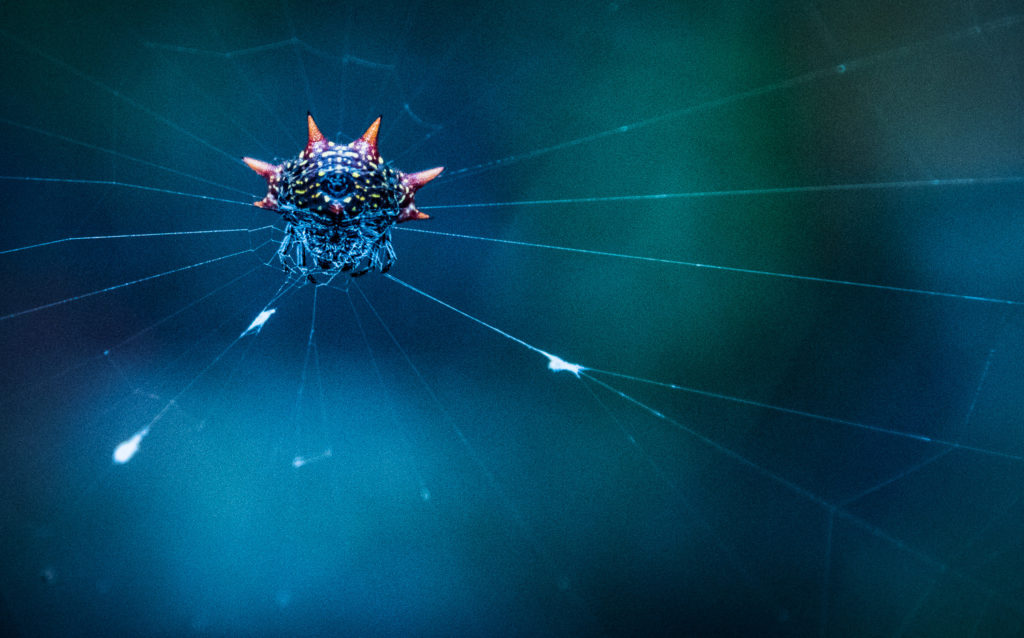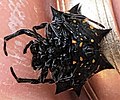
Hey, nature enthusiasts! Today, we’re diving into the whimsical world of one of Florida’s most fascinating and funky little critters: the Spiny-backed Orb-Weaver (Gasteracantha cancriformis). This spider is not only a master weaver but also a fashion icon in the arachnid world. So, grab your magnifying glass and let’s get up close and personal with this tiny yet spectacular architect of the natural world.
Meet the Spiny-backed Orb-Weaver
First things first, let’s talk about appearance. The Spiny-backed Orb-Weaver is like the Lady Gaga of spiders—bold, colorful, and impossible to ignore. These spiders are small, about the size of a pea, but what they lack in size, they make up for in style. Their bodies are adorned with bright colors—yellow, white, red, and black—and they have distinctive spiky protrusions that look like nature’s version of punk rock spikes. These spines aren’t just for show; they’re a defense mechanism, making the spider less palatable to predators. Talk about fashion with a function!
Home Sweet Web
The Spiny-backed Orb-Weaver is an absolute genius when it comes to web design. These spiders spin classic orb-shaped webs that are not only structurally impressive but also quite beautiful. Their webs can span several feet in diameter and are often strategically placed in gardens, forests, and between trees and bushes, making them prime real estate for catching unsuspecting insects.
What’s even more fascinating is that these spiders are meticulous about their webs. They rebuild them daily, ensuring they’re in tip-top shape to catch the day’s menu of bugs. Imagine having to rebuild your house every single day—talk about dedication!
A Day in the Life
Life for a Spiny-backed Orb-Weaver is a busy one. By day, they hang out in the center of their web, waiting for a meal to come to them. When an insect gets tangled in the sticky strands, the spider quickly scurries over to wrap it in silk and deliver a venomous bite. It’s like DoorDash, but the spider is the restaurant, delivery driver, and chef all rolled into one.
But it’s not all about work for these little guys. They also take time to ensure their webs are visible to larger animals that might accidentally walk through them. They add little tufts of silk to the web as warning signs, which is kind of like putting up a “Do Not Disturb” sign. Clever, right?
Social (Media) Spiders
In the spider world, Spiny-backed Orb-Weavers are the social butterflies. You’ll often find several of them living in close proximity, creating a web-filled community that’s buzzing with activity. They’re not exactly chatting over coffee, but they do seem to enjoy the company.
Fun Facts About the Spiny-backed Orb-Weaver
Before we wrap up our spider-ific adventure, let’s hit you with some fun facts about these fascinating critters:
- Wide Range: These spiders aren’t just Florida residents. You can find them throughout the southeastern United States, Central America, and even in parts of South America.
- Short Lifespan: Spiny-backed Orb-Weavers live fast and die young. Their entire lifecycle—from egg to adult—lasts about a year. They pack a lot of living into a short amount of time!
- Non-Aggressive: Despite their fierce appearance, these spiders are harmless to humans. They’re more interested in catching flies than biting people.
- Architects of the Insect World: Their webs are engineering marvels, designed to maximize their catch with minimal effort. Each web is a work of art and a functional tool rolled into one.
So, there you have it! The Spiny-backed Orb-Weaver is a testament to the wonders of nature, combining beauty, function, and a touch of whimsy. Next time you’re out in the garden or wandering through the woods, keep an eye out for these colorful little architects. They’re proof that sometimes, the smallest creatures can leave the biggest impressions. Happy exploring!
Gasteracantha cancriformis
Gasteracantha cancriformis[2] (spinybacked orbweaver) is a species of orb-weaver spider (family Araneidae). It is widely distributed in the New World.[1]
The genus name Gasteracantha derives from the Greek words γαστήρ (gaster, "belly") and ἄκανθα (acantha, "thorn"), while the specific epithet cancriformis derives from the Latin words cancer ("crab") and forma ("shape, form, appearance").
Description
Females are 5–9 mm (0.20–0.35 in) long and 10–13 mm (0.39–0.51 in) wide. The six abdominal spine-like projections on the abdomen are characteristic. The carapace, legs, and underside are black with white spots under the abdomen. Variations occur in the colour of the upperside of the abdomen - a white or yellow colour with both featuring black spots. A white upper side can have either red or black spines while a yellow upperside can only have black ones. Like with many other spiders, males are much smaller (2 to 3 mm long) and longer than wide. All morphs have six abdominal spines.[3][4] They are similar to the females in colour, but have a gray abdomen with white spots and the spines are reduced to four or five stubby projections.
This species of spider does not live very long. In fact, the lifespan lasts only until reproduction, which usually takes place in the spring following the winter when they hatched. Females die after producing an egg mass, and males die six days after a complete cycle of sperm induction to the female.
Distribution and habitat
G. cancriformis is native to North America, Central America, the Caribbean and South America.[1] It has been introduced elsewhere, including Hawaii. It prefers living around the edge of woodland and shrubby gardens. Many studies about G. cancriformis are performed in citrus groves in Florida.[1][5]
G. cancriformis is seen to coexist within and on the edges of the colonies of other colonial orb-weaver spiders, mainly Metepeira incrassata. M. incrassata is known to form large colonies ranging from few hundreds to few thousands of spiders, and their colonies often accommodate other species of orb-weavers including G. cancriformis.[6]
Taxonomy
G. cancriformis has two subspecies, G. c. cancriformis and G. c. gertschi.[7]
Gallery
-
Eating a butterfly
-
Ventral view, with spinneret visible
-
In Miami
-
In Miami Lakes
-
In Ecuador
-
In Novo Hamburgo (southern Brazilian population), with focus on the web
-
Mating in the Summer
-
On a tufted web in Houston, Texas
-
Color variation, near Houston
-
Underside of orange specimen, showing spinner and thread. For scale, band in background is 6 mm wide. Near Houston
-
Ventral view, in North Carolina
See also
References
- ^ a b c d "Taxon details Gasteracantha cancriformis (Linnaeus, 1758)", World Spider Catalog, Natural History Museum Bern, retrieved 2016-04-28
- ^ Peters, A. (2002). "Gasteracantha cancriformis". animaldiversity.org. Animal Diversity Web.
- ^ Levi, 1978
- ^ Muma, 1971
- ^ Peters, Annie. "Gasteracantha cancriformis". Animal Diversity Web. Retrieved 2021-10-27.
- ^ Hodge, Margaret A.; Uetz, George W. (September 1996). "Foraging advantages of mixed-species association between solitary and colonial orb-weaving spiders". Oecologia. 107 (4): 578–587. Bibcode:1996Oecol.107..578H. doi:10.1007/BF00333951. ISSN 0029-8549. PMID 28307403. S2CID 13382984.
- ^ Archer, Allan F. (1941). "Supplement to the Argiopidae of Alabama" (PDF). Geological Survey of Alabama. Museum Paper 18: 23–25.
Further reading
- Eberhard, William G. (2006): Stabilimenta of Philoponella vicina (Araneae: Uloboridae) and Gasteracantha cancriformis (Araneae: Araneidae): Evidence Against a Prey Attractant Function. Biotropica 39(2): 216-220. doi:10.1111/j.1744-7429.2006.00254.x
External links
![]() Media related to Gasteracantha cancriformis at Wikimedia Commons
Media related to Gasteracantha cancriformis at Wikimedia Commons









